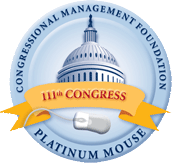By House Science & Technology Committee Chairman Bart Gordon (TN-6th)
Ten years ago, if someone were to mention a BlackBerry, I would have assumed they were talking about their breakfast or dessert. Today, it is part of the way we work. The information technology sector continues to be a vital part of America’s competitiveness. As the industry continues to expand, the U.S. must fight to remain as the leader to help home-grown businesses thrive and to provide jobs for American workers.
Since 1995, the networking and IT industries have accounted for 25 percent of U.S. economic growth, according to the National Research Council. The Science Coalition recently released a report that told the stories of 100 companies, including Google, Cisco and Hewlett-Packard, which were all created based on research funded with federal dollars. Robust public investments in the development of innovative new technologies are necessary to continue this economic growth and to create jobs in the decades to come.
IT jobs have already started to move to countries with lower wages. Moreover, the global IT marketplace is extremely competitive. America will only maintain its leadership in technology if appropriate investments are made.
At a time of rising deficits, we must do more with less. The federal government must help coordinate among agencies so that taxpayer money is spent wisely. We have to ensure that programs are run efficiently and that researchers are not duplicating efforts. By communicating effectively, questions can be solved more quickly and efficiently. That is why the Science and Technology Committee has moved to reauthorize the Networking and Information Technology Research and Development program. NITRD is the mechanism for coordinating research and development in advanced information technologies. The National Coordination Office ensures that the 13 participating federal agencies collaborate to increase the overall effectiveness and productivity of federal IT R&D.
Another way to encourage coordination and enhance our economic competitiveness in the IT industry is by strengthening public-private partnerships. In a hearing before the Science and Technology Committee just a few weeks ago, university and industry witnesses both said that the most important factor in successful technology transfer and ultimate commercialization of technology is the direct interaction and relationship building between academia and industry researchers.
Developments in IT continue to be essential to today’s societal progress — the Internet is an obvious daily reminder. Although you might not realize it, nanotechnology is a part of most Americans’ daily lives as well. The sunscreen you apply at the beach this summer is the result of nanotechnology. Nanotechnology can also help to reproduce or to repair damaged human tissue. Manufacturers using nanotechnology produce microchips that are faster and use less energy, enabling the miniaturization of countless devices, including computer processors and tools to detect cancer.
Nanotechnology is a broad term for the emerging field that incorporates and manipulates tiny particles in materials and devices. It has implications for all sectors of our economy including electronics, energy, materials and medicine. In short, nanotechnology is going to change the way we live by producing new scientific applications that are smaller, faster, stronger, safer and more reliable.
The Science and Technology Committee recognized early the importance of focusing and supporting federal efforts in nanotechnology research. In 2003, the committee introduced the widely supported bipartisan bill that was later signed into law as the 21st Century Nanotechnology Research and Development Act. This act formalized the National Nanotechnology Initiative and authorized support for federal nanotechnology R&D.
Again, effective coordination will ensure the efficiency of research, in this case nanotechnology. The National Nanotechnology Initiative is the central point of collaboration for the 25 federal agencies engaged in nanotechnology research.
The global market for nanotechnology products in the coming years is $150 billion to $3.1 trillion, with about 2 million new jobs being created worldwide by 2015. Since the creation of our American NNI, more than 60 nations have established their own national nanotechnology initiatives, many based on the U.S. model. We must continue our efforts to remain the global leader.
Continued research is the lifeblood of healthy information technology and nanotechnology industries. Fortunately, we laid out the path forward for the effective support of these industries in the America COMPETES Reauthorization Act.
The bill passed the House on May 28 and is awaiting Senate action. This landmark legislation puts our basic research programs on a path to doubling authorized funding levels. A theme of the America COMPETES Reauthorization Act is coordination, specifically embodied in the NITRD and NNI programs. These investments in science, innovation and education support employers today while strengthening the U.S. scientific and economic leadership to grow the new industries of tomorrow — and the jobs that come with them.
